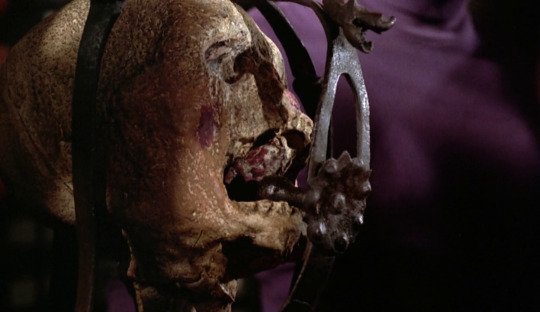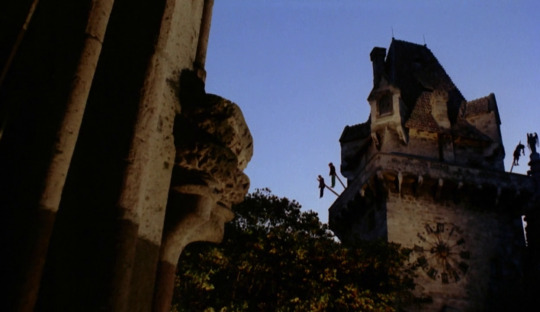#Rada Rassimov
Explore tagged Tumblr posts
Text




Gli orrori del castello di Norimberga (1972) dir. Mario Bava
#gli orrori del castello di norimberga#baron blood#rada rassimov#1970s horror#1970s movies#1972#mario bava#gothic horror#witch#ghost#flames#horrorgifs#gif#gifs#my gifs
186 notes
·
View notes
Text

Clint Eastwood-Rada Rassimov "El bueno, el feo y el malo" (Il buono, il brutto, il cattivo) 1966, de Sergio Leone.
19 notes
·
View notes
Photo

Gli orrori del castello di Norimberga 1972
5 notes
·
View notes
Text

Rada Rassimov as Bianca Merusi in The Cat o' Nine Tails (1971), directed by Dario Argento.
0 notes
Text
Movie Macabre 113 - Baron Blood

Movie Macabre Season 01 - Episode 13 (113) Original Air Date: 27 December 1981 (Final Episode of 1981)
Baron Blood (1972) (Original Title: Gli orrori del castello di Norimberga / The Horrors of Nuremberg Castle) Directed by Mario Bava Screenplay by Vincent G. Fotre, Willibald Eser, and Mario Bava
Starring: Joseph Cotten Elke Sommer Massimo Girotti Antonio Cantafora Alan Collins Humi Raho Rada Rassimov
"A young man, visiting the castle of a murderous ancestor in Austria, accidentally brings his dead relative back to life - searching for new victims." (IMDb)
Episode 13 of Movie Macabre was the first to feature a movie by director Mario Bava, considered one of the masters of Italian horror. Because of this reputation, my expectations were not in line with reality. I found this movie overall pretty dry. While there were a few moments of good atmosphere, very little about this movie really stands out.
Peter is visiting Austria, the place of his family's history. He's particularly interested in a "ghoulish" ancestor, a baron who tortured and murdered people. Peter believes he has the key to resurrect this long-dead evil. In the exact type of stupidity that only seems to exist in horror movies, Peter keeps trying to resurrect the baron until he succeeds. And then he's upset the baron is going around killing people.

Baron Blood casually murders a few people, while Peter and his friends try to solve the mystery of who is killing the people.
The movie's not all bad. There is competent film making hidden in the somewhat bumbling plot. There are some good practical effects.

I try to find the good in every movie I watch. Even if something's not to my tastes, there are usually redeeming qualities. Even movies that are completely incompetent can be enjoyable. But it's difficult to get past a movie that's just boring. Unfortunately, I found this movie boring. The plot wasn't compelling, and often relied on the characters being almost stupid in order for anything to happen. The atmosphere was largely akin to daytime television, except for a couple of standout moments. Much the movie felt added just to get the film to feature length. This particular film was made to be half watched while waiting for Elvira to pop up and comment on it.
I would be interested in seeing more (and better) Mario Bava films. He has a reputation as a master of horror cinema. Surely he didn't earn it for things like Baron Blood?
I bet Elvira would have livened up a viewing of Baron Blood. Someone somewhere has to have all of the episodes of Movie Macabre. Right?
#elvira#elvira mistress of the dark#horror host#70s horror#cassandra peterson#horror movies#horror film#horror#mario bava#baron blood
4 notes
·
View notes
Photo

Clint Eastwood in The Good, the Bad and the Ugly (Sergio Leone, 1966)
Cast: Clint Eastwood, Eli Wallach, Lee Van Cleef, Also Giuffrè, Luigi Pistilli, Rada Rassimov, Claudio Scarchilli, John Bartha. Screenplay: Agenore Incrocci, Furio Scarpelli, Luciano Vincenzoni, Sergio Leone. Cinematography: Tonino Delli Colli. Production design: Carlo Simi. Film editing: Eugenio Alabisi, Nino Baragli. Music: Ennio Morricone.
Clint Eastwood's Man With No Name* may be the movies' most famous picaro, the roguish hero who wanders through an often hostile landscape, surviving by his wits -- and in this case, his skill as a gunman. The picaro's heart is generally in the right place even if he doesn't mind breaking a few laws to get his way. In the first two films of Sergio Leone's "Dollars Trilogy," A Fistful of Dollars (1964) and For a Few Dollars More (1965), he is a loner, but in The Good, the Bad and the Ugly he has picked up an unlikely (and untrustworthy) sidekick in Tuco (Eli Wallach), with whom he is working a scam: Tuco has a price on his head, which our hero collects by bringing Tuco in to justice, and then splits with Tuco after rescuing him from a hanging. Tuco is a more vicious Sancho Panza to No Name's more capable Don Quixote. Leone himself once admitted his debt to the picaresque tradition, and The Good.... was filmed in Spain, where the tradition began with Lazarillo de Tormes in 1557 and produced its most influential analog in Don Quixote. But who, in the mid-1960s, when Leone was making movies derided as "spaghetti Westerns," would have anticipated such analysis or the veneration those films receive today? Half a century ago, when Leone's trilogy was being released, critics were raving about films like A Man for All Seasons (Fred Zinnemann, 1966), Doctor Zhivago (David Lean, 1965), and Becket (Peter Glenville, 1964): "prestige" movies on high-toned subjects that have dated badly, while Leone's movies still get enthusiastic viewings. The Good.... is overlong, especially in its latest restoration, which runs for 177 minutes, and there's some confusion in integrating the Civil War's New Mexico Campaign scenes with the story of the titular triad. But there are few scenes in movies more dazzling than Tuco's dash through the cemetery and the subsequent three-way standoff. Lee Van Cleef is a suitably scary Bad guy; Eastwood demonstrates the growth as an actor that would continue as his career soared; Wallach gives one of his best performances: and the contribution of Ennio Morricone is breathtaking. Raw and unpolished as The Good, the Bad and the Ugly at times is, it remains memorable filmmaking, while the films more celebrated in its day are mostly forgettable. *Actually, he picks up a name in each of Leone's "Dollars Trilogy" films: In A Fistful of Dollars he is called "Joe," which is a generic name for an americano. In For a Few Dollars More he is known as Monco, the Italian word for "one-armed," in reference to his tendency to use his left hand while keeping his gun hand under his poncho. And in the third film he is dubbed "Blondie" by Tuco. (The color of Eastwood's hair seems to me like a minor characteristic, but "Tall Guy Who Squints and Smokes Cheroots" would have been a mouthful.)
3 notes
·
View notes
Text
Baron Blood

The ads for Mario Bava’s BARON BLOOD (1972, Shudder, Tubi, Plex, YouTube) — aka THE HORRORS OF NUREMBERG CASTLE — indemnify theater owners against patrons suffering heart attacks, cerebral hemorrhages or fainting spells. They should have included narcolepsy. Apart from an atmospheric chase scene in the fog, the scenes with a medium (Rada Rassimov) and Joseph Cotten’s bravura performance (when he finally shows up), the film is more padded than frightening and seems one of the least personal of Bava’s career.
American student Antonio Cantafora shows up at his family’s ancestral estate with an ancient parchment containing a spell to return his sadistic ancestor to life. His courtship of pretty architecture student Elke Sommer includes reading the spell in the room where the late unlamented baron died, whereupon the wind blows the parchment bearing the reverse spell into a fire. So, a scarred corpse rises from the grave to kill people until it turns into Cotten, a wealthy old man who buys the castle and sets about getting the leads into his torture chamber so he can kill them before they send him back to hell.
It takes forever to get to that plot, and the torture scenes are decidedly weak tea. Instead, the script pads things out with Cantafora, who’s cute, flirting with the wooden Sommer, whose face is less expressive than the fright mask Cotten’s stand-in wears for the murder scenes. That’s not helped by Bava’s penchant for extremely tight closeups, which underline how little her face moves. Amazingly, nobody questions how the wheelchair-bound man keeps turning up in rooms that can only be reached by climbing stairs. The kills don’t have the zip of Bava’s best gialli, and he uses the zoom so much I wanted to break it over my knee and send him to bed without his supper. The film is also inflicted with an incongruous Euro-pop score that makes it sound like a sex comedy. American prints substituted a horror score by Les Baxter, but Shudder, in a misguided stab at cinematic integrity, uses the original.
0 notes
Photo

“The Good, the Bad and the Ugly” AKA Il buono, il brutto, il cattivo by Sergio Leone (1966) Eli Wallach and Rada Rassimov. #Cinema #Western
50 notes
·
View notes
Photo

Der Leone Have Sept Cabeças, Glauber Rocha (1970)
#Glauber Rocha#Gianni Amico#Rada Rassimov#Giulio Brogi#Gabriele Tinti#Jean Pierre Léaud#Aldo Bixio#Baiack#Reinhard Kolldehoff#Guido Cosulich#Baden Powell#Eduardo Escorel#1970
8 notes
·
View notes
Text








Gli orrori del castello di Norimberga - Baron Blood Mario Bava (1972)
#Gli orrori del castello di Norimberga#Baron Blood#Mario Bava#cinema italiano#italian horror#Joseph Cotten#Elke Sommer#Massimo Girotti#Rada Rassimov#Antonio Cantafora#Umberto Raho#Luciano Pigozzi#Dieter Tressler#Pilar Castle#Gustavo De Nardo#Nicoletta Elmi#Valeria Sabel#The Well to Hell hoax
20 notes
·
View notes
Text

Rada Rassimov in Gli orrori del castello di Norimberga (1972)
#gli orrori del castello di norimberga#baron blood#rada rassimov#1970s horror#1970s movies#1972#mario bava#gothic horror
49 notes
·
View notes
Text

Rada Rassimov (Trieste, Italia, 7/05/1938).
12 notes
·
View notes
Photo




The Cat o' Nine Tails (1971)
#the cat o' nine tails#dario argento#karl malden#james franciscus#catherine spaak#rada rassimov#movie gifs#my gifs#gifs#cinema#horror movies#horror#1970s#70s horror#70s movies
90 notes
·
View notes
Photo

The Cat o' Nine Tails
directed by Dario Argento, 1971
#The Cat o' Nine Tails#Il gatto a nove code#Dario Argento#movie mosaics#James Franciscus#Karl Malden#Cinzia De Carolis#Vittorio Congia#Rada Rassimov#Tino Carraro#Catherine Spaak
4 notes
·
View notes

